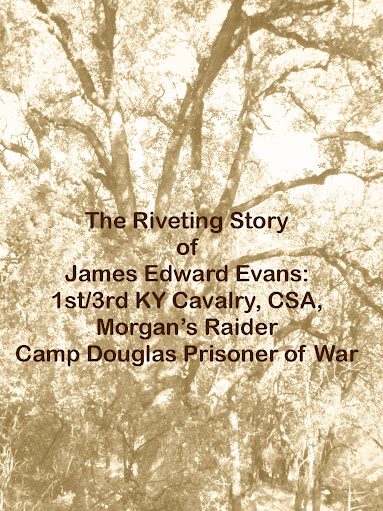March 3, 1863
“An Alphabetical Roll of Morgan’s Old Division Through 1863” shows James Edward Evans as having been wounded on March 3, 1863.[i] No details concerning the injury are included in this record.
Many questions race to mind. Was he wounded in a skirmish with Union pickets? What was the nature of the wound? How was the wound treated?
Little documentation remains to answer these questions.
“To each regiment of infantry or cavalry was assigned a surgeon and an assistant surgeon…”[ii]
“Every effort was made to treat wounded men within 48 hours; most primary care was administered at field hospitals located far behind the front lines. Those who survived were then transported by unreliable and overcrowded ambulances-two-wheeled carts or four-wheeled wagons-to army hospitals located in nearby cities and towns.
The most common Civil War small arms ammunition was the dreadful minnie ball, which tore an enormous wound on impact: it was so heavy that an abdominal or head wound was almost always fatal, and a hit to an extremity usually shattered any bone encountered. In addition, bullets carried dirt and germs into the wound that often caused infection.”[iii]
Family lore holds that his father, Dr. Isaac Greenup Evans, receiving word of James’ injury went by wagon and fetched him home. Isaac was intent on nursing his son himself. Letters from James’ elder brother John had revealed that Confederate field hospitals often lacked basic supplies and medications.
James, too weak to argue, returned home with his father. Yet, the moment he regained his strength, he left the family home in the middle of the night and returned to the Confederate Cavalry against his father’s will.
Sadly, no evidence to support or to disprove this family tale has been found.
What can be determined is the fact that Confederate surgeons did often suffer from lack of supplies.
“The surgeons and assistant surgeons, the generals and the officers lived with their men in the open fields, in trenches swept by the fire of the enemy, literally in ditches and holes burrowed in the earth, hair filled with water--from which they were sometimes in the rainy season driven out like rats. Half starved, upon the coarsest food, in cold and storm and rain, exposed to every hazard--these, our brethren of the medical department, quailed not; they patiently submitted to every hardship, often with systems shattered by privation and ill-health, whilst they performed services which required skill, care and serene courage.”[iv]
However, these dedicated men were not without remarkable cunning and resourcefulness.
“The Civil War surgeon could often be wounded or even killed. Hospitals sites were chosen close to the line and where water was available. Improvisation, particularly for the Confederate surgeon, was the name of the game. Hunter McGuire on the adaptability of the Confederate surgeon:
The pliant bark of a tree made for him a good tourniquet; the juice of the green persimmon, a styptic; a knitting needle, with it’s point sharply bent a tenaculum; and a pen knife, in his hand, a scalpel and bistoury. I have seen him break off one prong of a common table fork, bend the point of the other prong and with it elevate the bone in a depressed fracture of the skull and save life.”[v]
These revelations cause one to wonder, how did James manage to survive his wound?
ENDNOTES
[i] Watkins, Drs. Elizabeth and Dwight G. “ Morgan’s Light Brigade” Alphabetical Roll of Morgan’s Old Division Through 1863 pages 234 -235.
[ii] S. P. Moore, S. P., M.D., surgeon-general of the Confederate States army, address delivered at Richmond, Virginia, October- 19, 1875.
[iii] The Civil War Society's "Encyclopedia of the Civil War"
[iv] Porcher, F. Peyre, A. B., M. D., “Confederate Surgeons,” Southern Historical Society Papers. Vol. XVII. Richmond, Va., January-December. 1889.
[v] Goellnitz, Jenny. “An Opinon of the Civil War Surgeon,” eHistory.com http://ehistory.osu.edu/uscw/features/medicine/cwsurgeon/opinion.cfm
Subscribe to:
Post Comments (Atom)





No comments:
Post a Comment